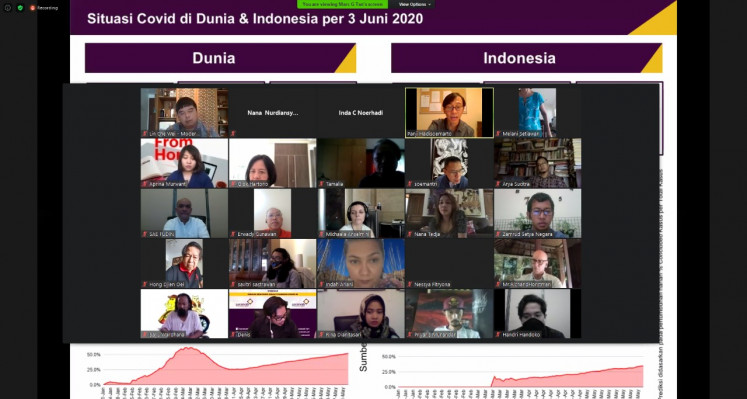Popular Reads
Top Results
Can't find what you're looking for?
View all search resultsPopular Reads
Top Results
Can't find what you're looking for?
View all search resultsIn search of post-COVID-19 economic protocol to stimulate Indonesian art world
Change text size
Gift Premium Articles
to Anyone
T
he massive disruption caused in the art and creative sector of the Indonesian economy by global governmental measures to limit the impact of the COVID-19 pandemic was the subject of a recent webinar.
Titled "Discussing the Fine Arts during the COVID-19 Pandemic", the webinar was conducted on June 4 and organized by Sarasvati Art Communication & Publication of Jakarta.
Moderated by Lin Chi Wei, founder of Sarasvati and the chair of an independent research institute that devises economic policy plans for the Office of the Coordinating Economic Affairs Minister, the webinar invited leading art figures to offer insight and solutions to curb the losses experienced in the arts.
Many artists and art workers have lost their source of income, and while art activities depend heavily on patrons, private funding and market mechanisms, in the national context, there is no social safety net for these people.
Some foreign governments and private sources, however, have launched social initiatives to help art workers. Intervention from the state and private sector is needed to ensure the continuity of the Indonesia art world during this pandemic.
In the open forum of about 30 people, Lin Chi Wei called for help on public figures including Oei Hong Djien, senior art patron and founder of privately-owned OHD Museum in Magelang, Central Java; Jasdeep Sandhu, director of Gajah Gallery Singapore and Yogya Art Lab in Yogyakarta; Soemantri Widagdo, founder of TiTian Art Space and the TiTian Awards; Zamrud Setyanegara, exhibition division head of the National Gallery of Indonesia; Suwarno Wisetrotomo, curator and senior lecturer at the Indonesia Art Institute (ISI) Yogyakarta, along with writers, curators, historians, art conservators and artists themselves.
“The objective of the webinar was to gain an overview of the current situation of artists, curators and museum/gallery managers in dealing with the COVID-19 pandemic, to get input and insight from some of these senior art stakeholders in responding to the pandemic, so that the art world can remain alive and create cooperation and networking between focus groups of producers, reviewers, organizations/institutions and the government,” Lin Chi Wei told The Jakarta Post.
“The goal is then to spearhead multi-discipline collaborative projects with these specific focus groups. Operational proposals for private sponsors and the government will have clearly defined objectives and outcomes in order to help spark a rebound and the development of the art sector post-COVID, so that specific stakeholders will be the beneficiaries.”
The 2.5-hour webinar began with information on the global and local pandemic situation by epidemiologist Panji Hadisoemarto to help develop a time frame about the virus and the possible reopening of the economy. Following this, the focus was on the development of online platforms to develop the local art ecosystem by increasing the exposure of Indonesian art to the world – where the challenge is to find new and sustainable models of collaboration.
During the discussion, words of encouragement were offered to artists from the OHD Museum and especially Jasdeep Sandhu, who stated that, “[now] is a good time to develop your work, and the art world is cyclic and has always endured ups and downs. Now with the benefit of new and dynamic online platforms, the internet can help lead us out of this crisis.”
On the subject of collectors and artist engagement, he added: “They must work together to find new common ground in their communications and be sensitive and prepared to be flexible and offer more incentives. It is now a buyer’s market.”
Soemantri Widagdo underlined the significance of the medium of storytelling through digital platforms to help in both the education of the art public as well as creating new value through explaining the specific importance of certain works of art. He also underlined the importance of developing markets for unknown and emerging Indonesian artists.
Art conserver Michaela Anselmini reminded institutions that the COVID-19 period was an excellent time to work on art conservation. Suwarno Wisetrotomo suggested eliminating event and exhibition opening ceremonies. Lin Chi Wei prompted the National Gallery to challenge the standards of social distancing and to renegotiate the rules, so that galleries and institutions could soon reopen.
The mood of participants during the webinar was upbeat and positive; many believed the pandemic was an enormous opportunity in disguise for positive sustainable growth and development in the Indonesian art world.
The path forward does, however, require a two-pronged approach: one looking at the short-term possibilities and potential, the other at a long-term strategy that takes into account the massive disruption and reset yet to come in the global financial and economic systems. (kes)












